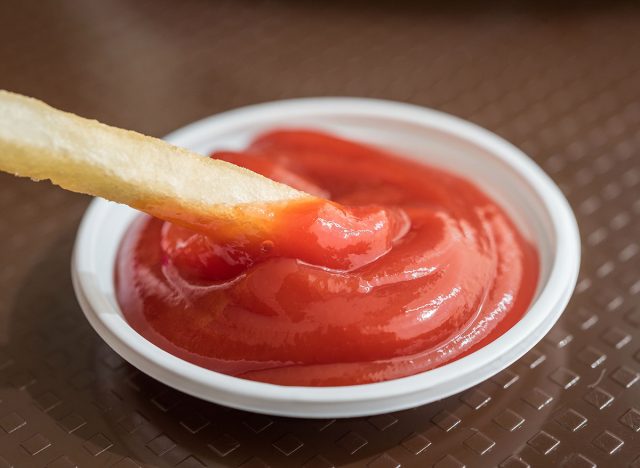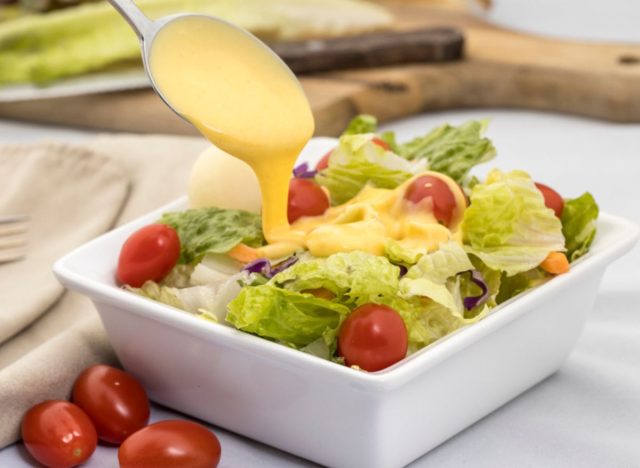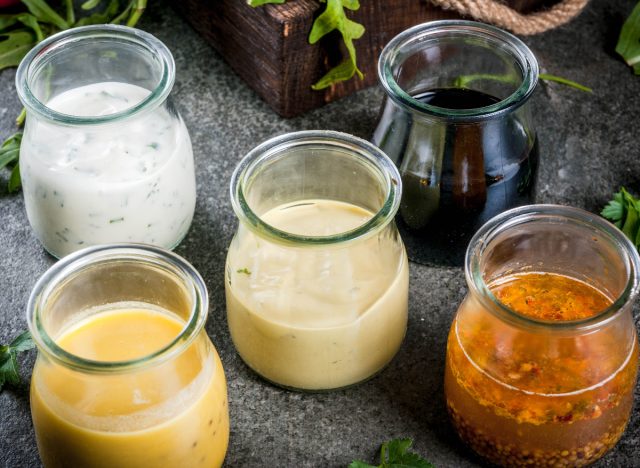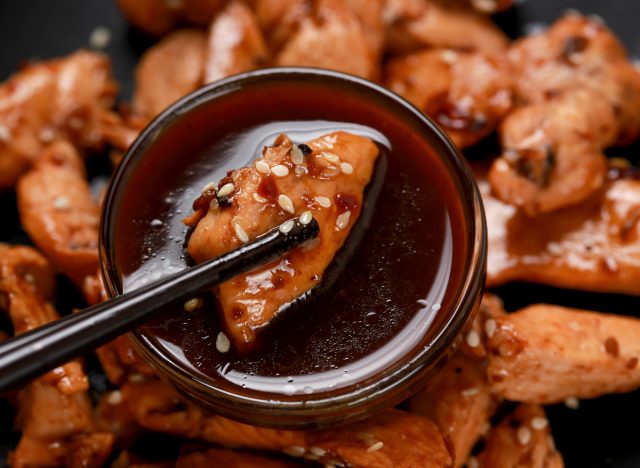The 4 Worst Condiments for Blood Sugar, According to a Dietitian

High blood sugar can stem from many factors, including stress, lack of sleep, and what you consume in your diet. When it comes to trying to maintain your blood sugar levels, added sugars can be one of the most problematic ingredients in food, and too much can even lead to chronic health conditions like diabetes. However, you may not always realize all the foods that added sugars are included in or even that you’re consuming it at all. Take condiments, for example—they might seem like harmless meal additions that do nothing more than provide your food a boost of flavor to help it taste better. But some condiments might be masking harmful ingredients that are doing more damage to your blood sugar than you might think.
“As with most packaged products, seemingly innocent, everyday condiments can contain hidden sources of sugar,” explains Laura Burak MS, RD, founder of GetNaked® Nutrition, and author of Slim Down with Smoothies. “So, my first piece of advice when perusing the aisles of the market is to look at ingredients first and begin to recognize words like ‘syrup,’ ‘dextrose,’ and ‘molasses,’ so you are more informed of what you’re buying and consuming.”
Burak also suggests thinking of the word “condiment” simply as just what it is—a food enhancer. As such, you don’t want to overpower your plate with an abundance of condiments that pale in comparison to the nutritional value of other more substantive foods.
“Instead of pouring excess sugar and salt on your food, condiments are a great way to enhance the taste of food and to get more healthy foods like veggies into your diet,” Burak says. “But just remember—a little goes a long way.”
Read on to see what Burak believes to be the worst condiments for blood sugar and shares her tips for how you can opt for better choices. Then, be sure to check out 4 Best Foods For Blood Sugar.
Ketchup

“Most ketchup on the market contains added sugar, usually in the form of high-fructose corn syrup,” explains Burak.
Eating too much high-fructose corn syrup has been known to lead to several health issues, including obesity, insulin resistance, and even diabetes.
“So, watch out for sources of sugar and check out grams per serving to make a better choice when it comes to picking ketchup,” says Burak.
Also, today there are plenty of low-sugar ketchups on the market to choose from, so try switching out your typical go-to ketchup choice for a more blood sugar-friendly option.
Honey mustard

Although honey on its own may provide certain health benefits, it still contains lots of sugar. To add insult to injury, the less organic condiment, honey mustard, doesn’t have all the same positive effects as honey might on its own.
“Honey is a ‘natural’ sugar, but it is still simple sugar,” explains Burak. “Your body will interpret it exactly the same way as table sugar. So although the word [‘honey mustard’] may make it sound healthier on the label, beware of the word ‘honey’ when used in condiments. It is just another way to add pure sugar to food.”
Instead, Burak recommends looking for mustards that don’t contain added sugar. If you still want that sweet honey taste, you can always add a touch of your own honey at home, and oversee exactly how much extra sugar is added by making your own DIY version of honey mustard.
Salad dressing

Do you know someone who likes to carry around their own bottle of homemade salad dressing, and even takes it with them to restaurants? Though it may seem extreme to some, perhaps they may be on to something. While salad dressing can liven up a bowl of fresh greens, bottled, store-bought dressings can be heavily processed and contain a lot of additives and sugars. So submerging your salad with certain store-bought dressing brands can detract from the nutritional value of a once-healthy meal.
“We need to begin to taste our food again in its basic form without the need to douse everything in dressings and sauces, aka excess sugar and salt,” Burak advises.
After reading the nutrition facts on store-bought salad dressings, you might find that the little extra effort it takes to whip up your own spin on classic dressings like ranch or green goddess is more worthwhile in the long run. Taking a DIY approach to salad dressings means saving yourself from the excess ingredients that can adversely impact your blood sugar.
Those who currently bring their own dressings to the party are already doing themselves a favor. Instead of guesstimating how much dressing has already been used, they have more oversight and control of their dressing portions.
“There’s a reason I suggest asking for dressing on the side when you eat out at a restaurant,” says Burak. “The chef will use a lot more than you will.”
Teriyaki sauce

You might’ve had teriyaki sauce in your Japanese takeout, or seen it slathered on your meat while sitting front row for a hibachi dinner. No matter when you cook with this delicious sauce, the temptation to pour teriyaki all over your veggies and meats is surely great. And while no one would blame you, there is a reason why this savory, sticky cooking staple seems sweet—that’s because it is.
“Bottled teriyaki sauce typically contains added sugar to give it that syrupy taste and thickness,” says Burak.
In addition to the added sugar content, store-bought teriyaki sauce can also contain additives, like cornstarch and high-fructose corn syrup, which can adversely impact blood sugars.
“Just make sure to use a little bit when you make your next stir fry,” Burak suggests.









